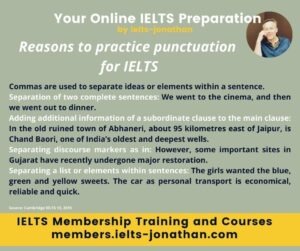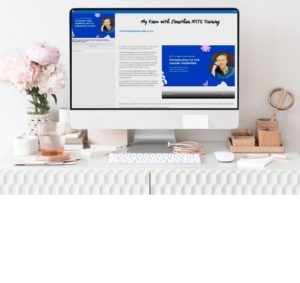Punctuation is a feature of the IELTS band scores. Although this aspect may come naturally to most students, it is often overlooked by students in the actual exam.
Simple punctuation errors or omissions can affect the meaning of your writing, it can also affect the progression and therefore affects the overall cohesion of the task.
What is punctuation in IELTS Writing and Reading
IELTS Writing
A major reason to practise effective punctuation in your writing is that it can make ideas clear and concise, for example,
In addition to the ideas already outlined, I also believe that work experience improves a person’s character and moral values.
IELTS Reading
Having a good understanding of basic punctuation can help you understand the ideas in IELTS reading more easily and work out the points made, thereby finding the answers you need.
Travel, except during the Dark Ages, has continued to grow and, throughout recorded history, has played a vital role in the development of civilizations and their economies.
Source: Cambridge IELTS 10, 2015
In both cases being able to use and understand punctuation can help increase your overall band score.
So what are the punctuation marks of English grammar that can help improve your IELTS writing.
The good news is that you don’t need to draw on all the punctuation marks that are a feature of English.
Apart from capital letters, there are definitely six types of punctuation to be aware of for the IELTS exam.
These are the full stops, commas, semicolons, colons, dashes and hyphens. Following their correct usage can make your writing easier to read and more appealing to the examiner and may help your understanding of IELTS reading passages.
The good news is ‘don’t worry’ about making some mistakes.
Even I make punctuation errors in my writing which I have to redraft and review!
Punctuation at the end of sentences
Only one of these punctuation marks is appropriate for use as sentence endings. This is the ‘full stop’ or in American English, the ‘period’.
A full stop is placed at the end of a sentence to show the end or completion.
Completed sentence:
The graph shows the number of households who own more than one television.
Another common use for IELTS is with numbers and dates:
was born on May, 18, 2019.
For IELTS General letter writing, it is common to use a full stop after abbreviations. This is just a ‘need to know’ convention of writing in English.
James Cooke sr. or James Cooke jr.
Comma, Semicolon, and Colon
These three punctuation marks are often incorrectly used in IELTS because all can indicate a pause in a series and this can lead to confusion.
The Comma
Commas are used to separate ideas or elements within a sentence.
- Separation of two complete sentences:
We went to the cinema, and then we went out to dinner.
- Adding additional information of a subordinate clause to the main clause:
In the old ruined town of Abhaneri, about 95 kilometres east of Jaipur, is Chand Baori, one of India’s oldest and deepest wells.
- Separating discourse markers as in:
However, some important sites in Gujarat have recently undergone major restoration.
- Separating a list or elements within sentences:
The girls wanted the blue, green and yellow sweets. The car as personal transport is economical, reliable and quick.
Another use of the comma is in numbers and dates.
The infamous meeting took place on Wednesday, August 31, 1973
As well as in General IELTS letter writing after the greeting and closing.
- Direct address in an IELTS General letter:
Thanks for all your help, Jane. All the best, Jonathan
The Oxford Comma
You can find lots of online information about whether to add a final comma before the conjunction in a list as in this example:
The children wanted the blue, green, and red sweets.
Known as an Oxford comma, one argument is that it can make writing clearer, especially in complex phrases, while others argue it is a simple stylistic choice.
Either way, it is probably an unnecessary consideration for IELTS writing and just something to be aware of.
The Semicolon
Semicolons (;) are used to connect independent clauses and help indicate a closer relationship between the clauses than a full stop could.
In the old ruined town of Abhaneri, about 95 kilometres east of Jaipur, is Chand Baori, one of India’s oldest and deepest wells; aesthetically it’s perhaps one of the most dramatic.
The colon
A colon (:) has three main uses.
The first is after a word introducing a quotation, an explanation, an example, or a series.
Students commonly study four core subjects in my country: English, maths, science, and a second language.
This growth (international travel) led to the development of a major new industry: tourism.
The second is between independent clauses when the second explains the first, similar to a semicolon:
Scientific progress is not all theoretical, knowledge is also vital to outstanding performance: individuals who know a great deal about a specific domain will achieve at a higher level than those who do not.
The third use of a colon is for emphasis:
At the age of thirty, Nobel made the first of his major inventions: an innovative blasting cap.
It is the second usage that is most likely seen in IELTS writing or reading.
A colon is also used in non-grammatical time and in ratios.
The meeting is scheduled for 11:30.
A 5:1 ratio was found to be the most suitable.
The Dash and the Hyphen
Two other punctuation marks to be aware of are the dash and hyphen.
These marks are often confused with each other due to their appearance but they are quite different and it is the ‘hyphen’ that can be regarded as more important in IELTS.
A dash is a device to separate words into statements. The most common type of dash is the en dash.
- The En dash is used in writing or printing to indicate a range, connections or differentiations, such as 1942-1945 or the London-Liverpool train.
A hyphen is used to join two or more words together into a compound term and is not separated by spaces. For example, part-time, back-to-back, well-known.
A well-known part-time job in my country is waitressing.
Finally,
Apostrophes
The final punctuation form in English grammar to be aware of for IELTS is the apostrophe.
An apostrophe (‘) is used to indicate the omission of a letter or letters from a word and for the possessive case.
Up to that point, she’d never seen her father’s dream car of the 1990’s and she wasn’t disappointed. The car’s condition was the same as her father’s description and she would’ve driven it there and then; except the keys had been lost.
We can say that the Lapitas’ canoes were capable of ocean voyages and so the real adventure didn’t begin until their Lapita descendants sailed out of sight of land, with empty horizons on every side.
Source: Cambridge IELTS 10, 2015
Examples of the apostrophe in use include:
It’s an important discovery that …….
Singular plural
Lapita’s trade with others …..
Possessive plural
The Lapitas’ canoes allowed them ….
For IELTS General writing, where the style and the tone of a Task 1 letter needs to be friendly or informal there are often an omission of letters from a word:
I’m writing to congratulate you on your birthday! I’ve seen that movie several times. She wasn’t the only person who knew the answer.
If possession or belonging to a group is indicated then the possessive apostrophe is used in a singular or plural form
Possessive case:
- Singular
Jane’s dog bit the neighbour’s cat.
- Plural
Janes’ dogs bit the neighbours’ cats.
The travel and tourism industry is the world’s largest employer and this industry is the world’s leading industrial contributor.
Omission
To show the omission of a number in a period:
In the ‘80s, during the ‘70s
Conclusion
As you can see from these illustrations, punctuation can be many things.
As a developing reader and writer, you should aim to have a clear understanding of common punctuation and functions for the reading text and be confident in using the basics of punctuation in your IELTS Task 1 and Task 2 writing.
You don’t need to be perfect, however you would be marked down on the simple or careless errors that result under test conditions.
Capital letters and full stops are a ‘must know’ and ‘do’, but also pay attention to the basic ‘comma‘ and the basic ‘apostrophe‘ to make ideas and meaning clear.
There isn’t much opportunity to go much further than these punctuation features in the limited words you have for writing so always check these in your proofreading and you should be fine.
Now try these exercises to test what you know
I’m Jonathan
I’ve taught IELTS and University English in more than a dozen universities and schools around the world.
I’m a parent, traveller and passionate about language teaching and helping students achieve their dreams.
Whilst living in Austria or working in Asia, I run IELTS courses to help students get to where they want to be.
If you are serious about IELTS, connect with me to see how I can help you.





Was this helpful? Leave a comment :)